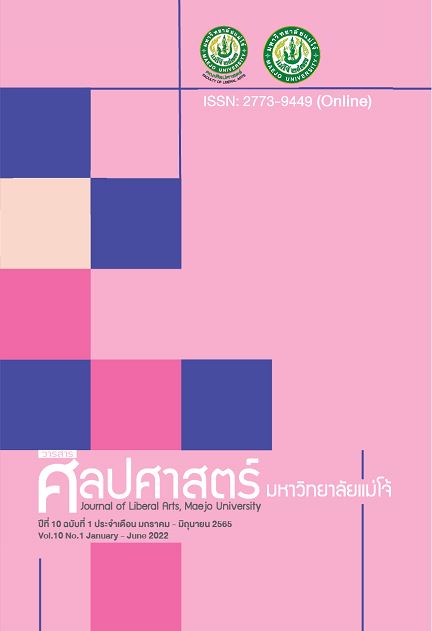Storage and Retrieval of Lanna Information Resources at the Institutes of Information Services in the Upper North of Thailand
Main Article Content
Abstract
This research aimed to explore the storage and retrieval of Lanna information resources at the institutes of information services in the Upper North of Thailand. This qualitative research used a semi-structured interview to collect data from 2 groups of key informants which consist of 1) 7 librarians and 2) 12 library users from 7 institutes of information services in the Upper North of Thailand. The results reveal that every institutes of information services acquires Lanna information resources by purchasing and requesting or donations. Some institutes of information services also have their own publications and replicate of the original resources from other libraries. Furthermore, they use Dewey Decimal Classification for classifies printed Lanna information resources, meanwhile, they use numerical filling system for each type of non-printed Lanna information resources. In addition, all institutes of information services have their own storages which include printed materials and non-printed materials, as well as electronic databases. Moreover, institutes of information services in the Upper North of Thailand’s users retrieve Lanna information by using Online Public Access Catalog (OPAC) twice a week and also purpose for studying and teaching in Lanna historical aspects. Most of users create their own words which are keyword, free term, natural language and specified words in both Northern Thai language and standard Thai language for information retrieval.
Article Details

This work is licensed under a Creative Commons Attribution-NonCommercial-NoDerivatives 4.0 International License.
ต้นฉบับที่ได้รับการตีพิมพ์ในวารสารคณะศิลปศาสตร์ มหาวิทยาลัยแม่โจ้ ถือเป็นกรรมสิทธิ์ของมหาวิทยาลัยแม่โจ้ ห้ามนำข้อความทั้งหมดหรือบางส่วนไปพิมพ์ซ้ำ เว้นเสียแต่จะได้รับอนุญาตจากมหาวิทยาลัยฯ เป็นลายลักษณ์อักษรReferences
คณะทำงานกลุ่มวิเคราะห์ทรัพยากรสารสนเทศ ห้องสมุดสถาบันอุดมศึกษา. (ม.ป.ป.). หัวเรื่องภาษาไทยออนไลน์. สืบค้น 26 กุมภาพันธ์ 2564, จากhttps://webhost2.car.chula.ac.th/thaiccweb/main.php
จามจุรี จิโนสวัสดิ์. (2560). การจัดการสารสนเทศภูมิปัญญาท้องถิ่นล้านนาของมหาวิทยาลัยในประเทศไทย(วิทยานิพนธ์ปริญญาศิลปศาสตรมหาบัณฑิต). เชียงใหม่: มหาวิทยาลัยเชียงใหม่.
ชลวิทย์ จิตมาน. (2561). การราบรวมและวิเคราะห์หัวเรื่องสมุนไพรไทย (วิทยานิพนธ์ปริญญาศิลปศาสตรมหาบัณฑิต). กรุงเทพฯ : มหาวิทยาลัยรามคำแหง.
เชียงใหม่, มหาวิทยาลัย คณะสถาปัตยกรรม. (2556). ศูนย์สถาปัตยกรรมล้านนา. สืบค้น 25 กุมภาพันธ์ 2564, จากhttps://www.lanna-arch.net/
เชียงใหม่, มหาวิทยาลัย โครงการล้านนาคดีศึกษา. (2557). ล้านนาคดีศึกษา. เชียงใหม่: โครงการล้านนาคดีศึกษา. มหาวิทยาลัยเชียงใหม่.
เชียงใหม่, มหาวิทยาลัย ศูนย์ส่งเสริมศิลปวัฒนธรรม. (2529). สถานภาพล้านนาคดีศึกษา. เชียงใหม่: ศูนย์ส่งเสริมศิลปวัฒนธรรม มหาวิทยาลัยเชียงใหม่.
เชียงใหม่, มหาวิทยาลัย สำนักงานขับเคลื่อนยุทธศาสตร์. (2562). Creative Lanna. สืบค้น 25 กุมภาพันธ์ 2564, จากhttps://creativelanna.cmu.ac.th/
โชคธำรง จงจอหอ และมาลี กาบมาลา. (2560). พฤติกรรมการแสวงหาความรู้ภูมิปัญญาข้าวไทย. วารสารอินฟอร์เมชั่น. 24(1), 70-89.
ณภัทร ฉิมพาลี. (2560). การกำหนดหัวเรื่องภาษาไทยด้านวัฒนธรรมล้านนา. (วิทยานิพนธ์ปริญญาศิลปศาสตรมหาบัณฑิต). เชียงใหม่: มหาวิทยาลัยเชียงใหม่.
นภัสกร กรวยสวัสดิ์. (2559). การบูรณาการแนวคิดของปัจเจกวิธาน(FOLKSONOMY)ในการสร้างหัวเรื่องสำหรับทรัพยากรสารสนเทศในสาขาบริหารธุรกิจและเศรษฐศาสตร์ (วิทยานิพนธ์ปริญญาปรัชญาดุษฎีบัณฑิต). ขอนแก่น: มหาวิทยาลัยขอนแก่น.
นภัสกร กรวยสวัสดิ์, ลำปาง แม่นมาตย์ และมาลี กาบมาลา. (2561). พฤติกรรมการเข้าถึงสารสนเทศและการใช้คำศัพท์ในการสืบค้นทรัพยากรสารสนเทศ สาขาบริหารธุรกิจและเศรษฐศาสตร์ของผู้ใช้. วารสารสารสนเทศศาสตร์. 36(1), 69-108.
ประกายดาว ศรีโมรา. (2541). การใช้รายการเข้าถึงแบบออนไลน์ของข่ายงานสารสนเทศห้องสมุดในจุฬาลงกรณ์มหาวิทยาลัยโดยวิเคราะห์จากบันทึกสถิติการสืบค้น (วิทยานิพนธ์ศิลปศาสตรมหาบัณฑิต) กรุงเทพฯ : มหาวิทยาลัยธรรมศาสตร์.
พรพรรณ จันทร์แดง. (2557). ห้องสมุดยุคใหม่. กรุงเทพฯ: ซีเอ็ดยูเคชั่น.
พัฑรา พนมมิตร. (2560). การพัฒนาออนโทโลยีความรู้ด้านผ้าล้านนา. (วิทยานิพนธ์ปริญญาศิลปศาสตรมหาบัณฑิต). เชียงใหม่: มหาวิทยาลัยเชียงใหม่.
รื่นฤดี ไชยวิชิตกุล. (2546). ความสามารถในการกำหนดคำค้นเพื่อการค้นหาสารสนเทศของนักศึกษาระดับปริญญาตรี สถาบันเทคโนโลยีพระจอมเกล้าพระนครเหนือ (วิทยานิพนธ์ปริญญาศิลปศาสตรมหาบัณฑิต). กรุงเทพฯ: มหาวิทยาลัยศรีนครินทรวิโรฒ.
ระเบียบ สุภวิธี.(2555). แหล่งสารสนเทศสำหรับงานบริการสารสนเทศเพื่อช่วยการค้นคว้า. นครปฐม : ภาควิชาบรรณารักศาสตร์ คณะอักษรศาสตร์ มหาวิทยาลัยศิลปากร.
วัลลภา ปัญญาวงศ์. (2539). การใช้และความต้องการสารนิเทศของนักวิจัยสาขาล้านนาคดีศึกษา (วิทยานิพนธ์ปริญญาอักษรศาสตรมหาบัณฑิต). กรุงเทพฯ: จุฬาลงกรณ์มหาวิทยาลัย.
ศุภวรรณ อาจกล้า. (2559). พฤติกรรมการแสวงหาสารสนเทศของนักศึกษาต่างชาติ มหาวิทยาลัยเชียงใหม่(วิทยานิพนธ์ปริญญาศิลปศาสตรมหาบัณฑิต). เชียงใหม่: มหาวิทยาลัยเชียงใหม่.
สมพร พุทธาพิทักษ์ผล, วรนุช สุนทรวินิต, นันทพร ธนะกูลบริภัณฑ์, พรทิพย์ สุวันทารัตน์, ศิริน โรจนสโรช, เครือทิพย์ เจียรณัย, และชัยวัฒน์ น่าชม. (2553). การจัดการสารสนเทศจากภูมิปัญญาท้องถิ่นด้านนนทบุรีศึกษา เพื่อส่งเสริมบริการห้องสมุดสู่ชุมชน. (รายงานการวิจัย). นนทบุรี: สำนักบรรณสารสนเทศ มหาวิทยาลัยสุโขทัยธรรมาธิราช.
สมหมาย เที่ยงในญาติ. (2550). หัวเรื่องภาษาไทยด้านการท่องเที่ยว. (วิทยานิพนธ์ปริญญาศิลปศาสตรมหาบัณฑิต). กรุงเทพฯ: มหาวิทยาลัยรามคำแหง.
สีปาน ทรัพย์ทอง. (2558). การจัดเก็บและการค้นคืนสารสนเทศ. ใน เอกสารการสอนชุดวิชา สารสนเทศศาสตร์เบื้องต้น หน่วยที่ 9-15. พิมพ์ครั้งที่ 5. นนทบุรี: มหาวิทยาลัยสุโขทัยธรรมาธิราช.
สุฑารัตน์ คำโสภา. (2550). หัวเรื่องภาษาไทยด้านการวิเคราะห์ผลกระทบสิ่งแวดล้อม (วิทยานิพนธ์ปริญญาศิลปศาสตรมหาบัณฑิต). กรุงเทพฯ: มหาวิทยาลัยรามคำแหง.
อรชร โอทองคำ. (2550). หัวเรื่องภาษาไทยสาขาการบัญชี (วิทยานิพนธ์ปริญญาศิลปศาสตรมหาบัณฑิต). กรุงเทพฯ : มหาวิทยาลัยรามคำแหง.
อังคณา แวซอเหาะ และสุธาทิพย์ เกียรติวานิช. (2555). การค้นคืนสารสนเทศบนอินเทอร์เน็ตของนักศึกษาคณะศิลปะศาสตร์ มหาวิทยาลัยเทคโนโลยีราชมงคลพระนคร. (รายงานการวิจัย). กรุงเทพฯ: คณะศิลปะศาสตร์ มหาวิทยาลัยเทคโนโลยีราชมงคลพระนคร.
Anfinnsen, S., Ghinea, G., & de Cesare, S. (2011). Web 2.0 and folksonomies in a library context. International Journal of Information Management. 31, 63-70.
Carman, N. (2009). LibraryThing Tags and Library of Congress Subject Headings: a Comparison of Science Fiction and Fantasy Works. (Master of thesis). Victoria University of Wellington
Choo, C.W. (2002). Information management for the intelligent organization: The Art of scanning the environment. 3rd ed. Medford, N.J.: Published for the American Society for Information Science and Technology.
Dewey, M. (2003). Dewey decimal classification and relative index. 22nd ed. Dublin, Ohio: OCLC, Online Computer Library Center.
Kumbhar, R. (2012). Library Classification Trends in the 21st Century. Witney: Chandos Publishing.
Larissah. (2007). PennTags: University of Pennsylvania Public Library. Retrieved December 12, 2020, from https://larissah.wordpress.com/2007/12/06/penntaggs/
Library of Congress. (n.d.). Library of Congress Classification Outline. Retrieved February 19, 2021, fromhttps://www.loc.gov/catdir/cpso/lcco/
Lu, C., Park, J., & Hu, X. (2010). User tags versus expert-assigned subject terms: A comparison of LibraryThing tags and Library of Congress Subject Headings. Journal of Information Science. 36(6), 763-779.
Mendes, L., Quinonez-Skinner, J., & Skaggs, D. (2009). Subjecting the catalog to tagging. Library Hi Tech. 27(1), 30-41.
Noruzi, A. (2006). Folksonomies: Uncontrolled Vocabulary. Knowledge Organization. 33(4), 199-203.
Rahman, A.I.M. Jakaria. (2012). Social tagging versus Expert created subject headings. (Master of thesis). Oslo and Akershus University College of Applied Sciences
Steele, T. (2009). The New cooperative cataloging. Library Hi Tech, 27(1). 68-77.
Wal, T. V. (2005). Folksonomy Definition and Wikipedia. Retrieved December 12, 2020, fromhttp://www.vanderwal.net/random/entrysel.php?blog=1750

